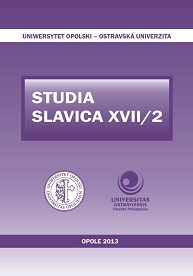Arbesovo romaneto Sivooky demon a Urbanova novela Michaela (literarneteoreticka komparace s ohledem k zanrovemu profilu)
Arbes’s Romanetto The Grey-Eyed Demon and Urban’s Novella Michaela: A Literary-Theoretical
Comparison with Regard to the Genre Profile
Author(s): Richard ZmělíkSubject(s): Literary Texts
Published by: Uniwersytet Opolski
Keywords: Genre; gothic novel; narratology; semiotics; fictional world
Summary/Abstract: The article discusses two mystery novellas: The Grey-Eyed Demon by Jakub Arbes (1840–1914) and Michaela by Milos Urban (b. 1967). Although the gap between the two texts is more than 130 years, a common influence of gothic novel is discernible in both of them. Each of the works, however, adapts this influence in different cultural and literary contexts. Arbes entered the world of Czech literature in the 1860s and his ambition was to create a genre of prose narrative that would be able to absorb both the techniques of high literature and the elements of popular reading. By achieving this, he wanted to create a modern literary genre. The Grey-Eyed Demon is an exemplary case of such an encounter. In this text, Arbes makes use of the devices of gothic fiction, whose romantic itinerary, however, the author tries to transform into a realistic mode of representation. The encounter of two different sets of artistic techniques and principles in this romanetto, however, is not without some difficulties, represented by striking „seams“ that are discernible especially on the thematic and narrative levels. It is not without interest that, in the same year, Arbes published an important romanetto, entitled Saint Xaverius, in which these dividing lines are not as obvious – indeed, Saint Xaverius is one of the peaks of Arbes’s oeuvre. Urban’s novella is a different case of contextualisation of gothic fiction. Urban makes use of the genre’s devices in post-modern fiction, in which they serve an entirely different purpose. In this case, it is an indexical reference (thematisation) to an older genre, which had lost its direct lineage in literature. This reference takes place within a post-modern tendency, which might be understood as discourse overlapping, a palimpsest-like quality, a semantic game based on re-contextualisation of historicising themes, motifs and other elements.
Journal: Studia Slavica
- Issue Year: 17/2013
- Issue No: 2
- Page Range: 141+-152
- Page Count: 11

